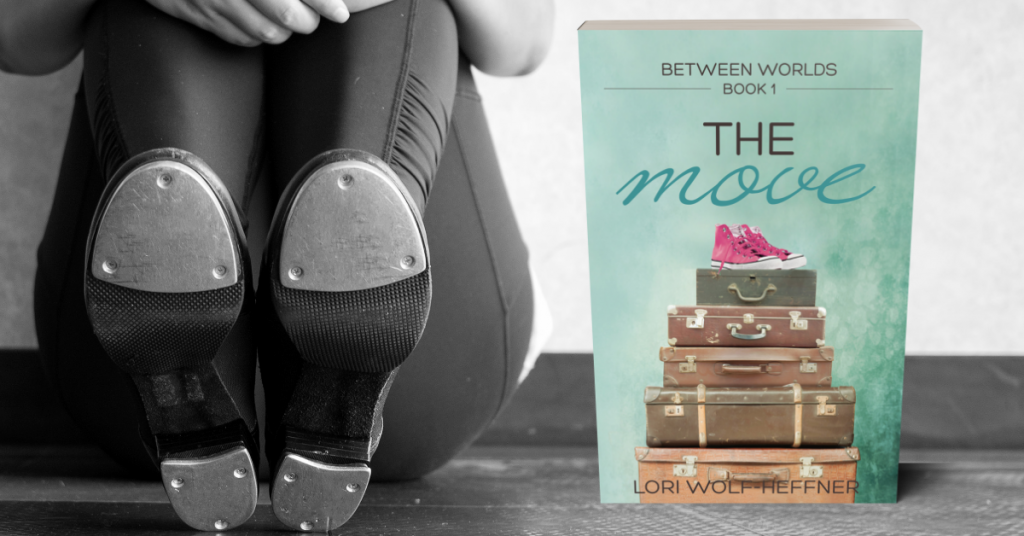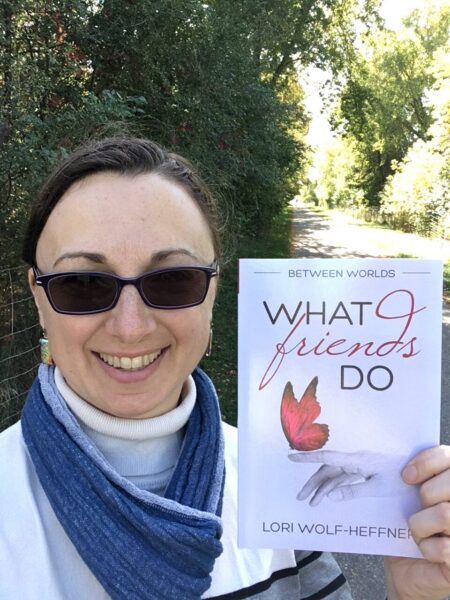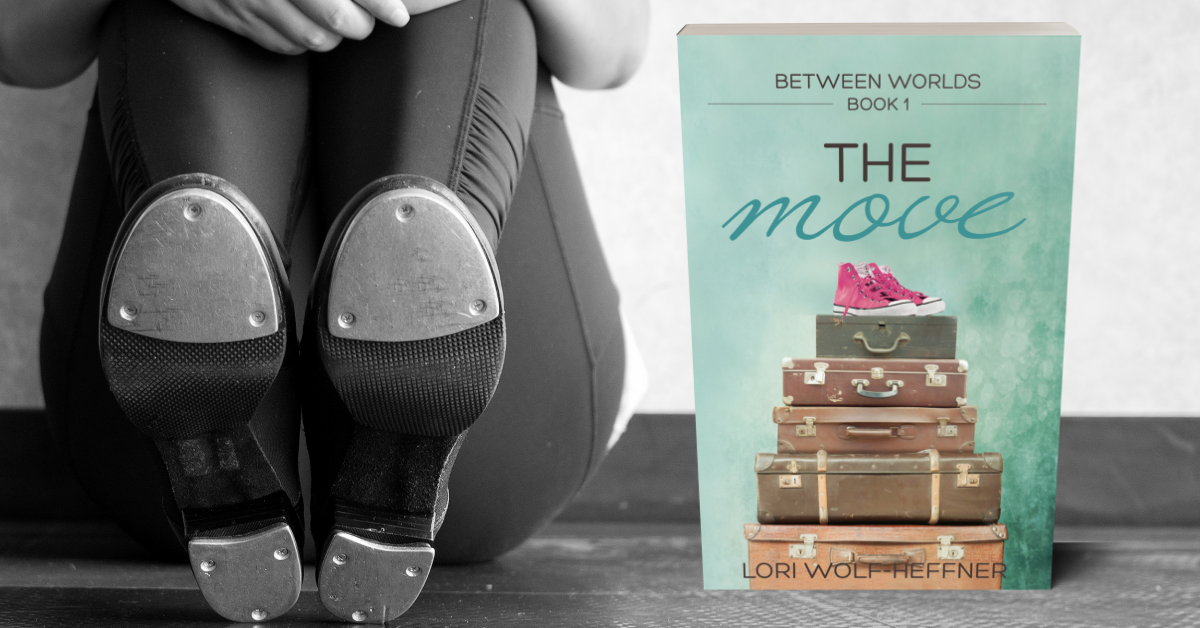In my world of dance fiction, dance has more uses for storytelling than just “Will I pass this audition? Will I make it?” I love exploring the possibilities. A student of dance since I was 2.5 years old, I’ve written dance into many of my novels: the entire Between Worlds young adult series and two of my Love on Belmont sweet romance novels for adults. It will also form the backbone for my next young adult series, currently in the planning stages.
In this blog post, I’ll explain the themes important in my dance fiction, share why I enjoy writing it, and offer tips on writing dance fiction if you love dance, too. (You don’t have to have extensive training either.)
Uncommon Themes in Dance Fiction
The dance fiction I read as a kid often focused on “making it,” i.e., passing an audition, or successfully getting through the day at an elite ballet school. Many dance movie plots centre around this character goal, too. I already hear “Five, six, seven, eight!” from A Chorus Line.
I never turned professional. Does that mean my dance education was a waste of time? Hardly. That’s why I wrote Between Worlds, my young adult series about a teen dancer who’s going through some tough times and uses dance in part to pull herself through.
But having a successful career in dance isn’t a horrible thing by any stretch! So, what about those who made it? Professional dancers typically retire in their 30s and 40s. The other part that rarely gets portrayed in dance fiction (and dance movies) is dancers at the end of their career. Turning Point, with Shirley MacLaine, Anne Bancroft, and Mikhail Baryshnikov, is perhaps the closest I’ve found so far.
So, enter from stage right world ballet star Todd Parsons in Tea Shop for Two, and in a parallel career as a pro sports mascot actor, Pauline Robinson.
Or what about dancers diagnosed with a hidden disability? We may read about dancers who are injured and then return to training once everything’s better, but how would a dancer balance dealing with a disability while still yearning to become a professional dancer?
Young ballet dancer Austin in Tea Shop for Two and Oh, What the Fudge is currently just a supporting character as a teen in an adult sweet romance series, but he will soon be the star of his own young adult dance fiction series. His diagnosis of epilepsy in his teens throws him a curveball he didn’t anticipate.
Whether you’re a dance enthusiast or simply searching for young adult reads for the young dancer(s) in your family, my dance fiction to date has something to offer.
Dance Fiction vs. Non-Fiction
Dance fiction and non-fiction may both explore the world of dance, but they approach it from different angles.
I research dance when I need to, either through non-fiction books, which provide insights into the history, techniques, and biographies of dancers, or by taking dance class.
But I don’t write non-fiction dance books.
Dance fiction takes readers on a fictional journey through the lives of dancers. Through it, I can freely explore areas of the dance world and how dance affects people in different situations. I can also let characters say whatever they need to so the plot keeps readers interested.
But ultimately, I want to show that dance helps us get through life.
Popular Dance Fiction Books and Authors
If you enjoy reading dance fiction, here are a few names to try. I haven’t read all of them myself, but they are popular or have received good reviews:
Young Adult Dance Fiction Books
- Tiny Dancer, by Siena Cherson Siegel and Mark Siegel
- Exit Stage Right and Face Off, both by fellow local author Jennifer Willcock
- The Other Side of Perfect, by Mariko Turk
- I Wanna Be Where You Are, by Kristina Forest
- Pirouette, by Robyn Bavati
Dance Fiction Books in the Sweet Romance Genre
- The Cheat Sheet, by Sarah Adams
- Into Your Arms, by Abigail Storm
- The Muse: A Pride and Prejudice Variation, by Jessica Evans
- With a Twist, by Staci Hart
Researching and Incorporating Dance Styles into Fiction
Even though I studied dance in my youth for over 15 years and also take adult lessons when time allows, I still research, as I mentioned earlier.
That’s because even within the major forms of Western dance, e.g., ballet, tap, jazz, hip hop, there are different styles. Ballet is the easiest one for me to talk about: you’ll find Vaganova (Russian), Cecchetti (Italian), Royal Academy of Dance (English), and French styles perhaps the most well known. Other styles of ballet do exist, however.
Tap teachers and choreographers differ in their terminology to some degree but more predominantly (at least in my experience) in their counting. Some count in da and de, others in ta and te, and yet others will use numbers. And let’s not forget that some will mix it all together. Hands are often involved, clapping to either keep the beat, emphasize a difficult passage, do both, or act like feet tapping in the air.
Sitting in on a class or two to watch is ideal, but if you don’t have strong connections to a studio, you may find this difficult: understandably, adults in care of children won’t let just any adults sit in to watch children. But thankfully, the internet is full of videos, so you should be able to watch there a lot there these days.
Just ensure that you characters are consistent. For example, a ballet instructor who teaches only Cecchetti will only change vocabulary or technique if they have good reason to do so.
Challenges and Rewards of Writing Dance Fiction
Writing dance fiction comes with its own set of challenges and rewards. One of the challenges is effectively conveying the physicality and visual beauty of dance through words alone. For example, try this excerpt from Tea Shop for Two, where Todd is leading Pauline in improv dance.
…Todd raised their grasped hands to shoulder height. He released his fingers, so she followed, and he pressed his hand against hers. She followed again.
The pressure between their hands moved outwards and down. At first, Pauline simply copied Todd, turning her back when he turned his, leaning her head back onto his shoulder when he did so with his head to her shoulder. But once their cheeks touched and she closed her eyes, something changed: the energy she imagined feeling in a room of people now surged through them, the music leading it. She found herself stepping away from Todd as they each dropped into a deep lunge, held together only by their hands, feeling alone and barely able to hold on but by a metaphorical thread, a feeling she experienced sometimes when visiting terminally ill children. She couldn’t talk about it to anyone outside her line of work because it upset them too much. The closest she could get was others in her profession, usually big, strong, young men who turned to puddles at the mere mention of sick children and changed the topic.
Love on Belmont 1: Tea Shop for Two
Dance is a visual art form, and capturing its essence on the page without boring the reader through copious description is tough. Some have told me they found these descriptions hard to follow, for example. This passage is from Pauline’s perspective, so I couldn’t use any technical terminology.

Contrast that to Juliana’s dance sessions, which I often use to dissipate her emotions. This passage comes from Between Worlds 1: The Move, and Juliana is dancing with her Calgary dance group for the last time.
The music came on. Juliana, standing sideways, her head bent down and her right hand grabbing the rim of an invisible hat, dropped her heel in time with the beat, a simple rhythm to start the number. Then, one by one, each dancer heel-dropped to their own rhythm, creating a percussion foreground for the music. On a loud cymbal crash, they turned front, their heads down, waited eight counts, and then jumped into the opening riff sequence.
As Juliana’s feet slammed onto, slid along, and grazed across the floor, she thought of the conversation she’d had with Mom in the car on the way to the studio.
Between Worlds 1: The Move
Thanks to one of my editors, Susan Fish, that dance sequence turned into a vehicle for backstory, thereby saving the need to repeat all of Juliana’s emotions as she performed a three-minute routine.
At least when you have to describe a painting or a photograph, you can usually work with vocabulary and imagery your readers know. Dance provides a challenge because much of a vocabulary is unfamiliar to readers; depending on the style of dance, the vocabulary differs; and each character has their personal approach to dance that needs to be honoured and portrayed.
Which brings me to my tips for you if you’d like to try your hand at dance fiction.
7 Tips for Aspiring Dance Fiction Writers

If you’re looking to write dance fiction yourself, these tips may help:
- Just because you didn’t grow up taking dance lessons doesn’t mean you can’t write dance fiction. You most certainly can! But follow the rest of these suggestions so your book doesn’t read like it was written by a novice.
- Research extensively: study the history, techniques, and cultural significance of the dance forms you want to use in your novel. Most ballet dancers, for example, don’t say “spinning” and “dancing on my toes” the way a layperson would. Thankfully, social media, online syllabi, and awareness days can help you create realistic portrayals.
- Connect with dancers: interview dancers, attend workshops, and engage with the dance community. Their insights and experiences can provide invaluable inspiration and authenticity to your writing. But always ask about their background. A dancer who trained in an average-sized city in Canada will have had a different experience from one who trained in LA.
- Find a balance between being true to dance and realizing your reader may not know what a chaîné turn is: I struggle with this frequently. I believe that for many laypeople, a “pirouette” is any turn, but for dancers, it’s a specific turn. In Tea Shop for Two, Todd says “pirouette.” Pauline, on the other hand, refers to this step performed by the man she is falling in love with as “spinning like the letter p.”
- Don’t forget to include a range of characters: not all dancers are snobs, perfectionists, bunheads, backstabbers, or people with eating disorders. If you’re having a hard time steering clear of stereotypes, create your characters first, then add dance to their profile and see how that affects their personalities.
- Don’t be afraid to express dance as emotion instead of steps: overwhelming readers of dance fiction with technical details can lead to boredom because it’ll feel like an information dump. And because it has emotion, it must have a reason for being in your book. Although dance fiction needs dance—obviously!—each dance scene must have a purpose.
- Consider having others read your work: if you’re new to writing dance fiction, ask people who might enjoy reading your work to give you some feedback. (Asking someone who loves action novels to read a romance dance fiction excerpt, for example, may not illicit the comments you’re hoping for.)
Conclusion
Dance fiction usually focuses on a dancer—either a student or professional—“making it.” As a kid, this led me to believe that the only reason for studying dance was to become professional. That didn’t happen.
Instead, I learned over time how useful dance became in other areas of my life. Once I began penning dance fiction novels, I wanted to expand the genre to include more storylines, most importantly, dance as a way to get through life. So, whether you’re a dance enthusiast or simply seeking an escape into a world of passion and grace, you’ll hopefully find dance fiction here that fits your reading desires or those of a young person in your life.

We manage all data submitted as outlined in our privacy policy.